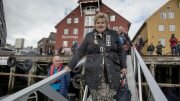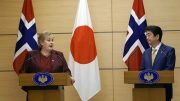September 13 was the day that Norwegians headed to the polls to vote in the national parliamentary elections. The day started with one Prime Minister voting in Bergen and ended with a new Prime Minister declaring victory in Oslo. Here’s how events unfolded yesterday…
Norway decides for a change of government
Norway has a new government. The center-right coalition government, led by Conservative Party (Høyre, H) leader, and Prime Minister, Erna Solberg, was booted out of office after 8 years in power. A new center-left government, led by Labour Party (Arbeiderpartiet, AP) leader, and now new Prime Minister, Jonas Gahr Støre, finally gets his chance after serving more than 7 years as opposition leader.
The change of government was heavily dependent on the Centre Party (Senterpartiet, SP) and Socialist Left Party (Sosialistisk Venstreparti, SV) increasing both their seats in the Storting and voter share. The two main partners in the former government, H and Progress Party (Fremskrittspartiet, FrP) lost not only 15 seats, saw their vote share decrease dramatically but also lost the right to govern Norway.
Advance votes and opinion polls
The first stirrings of a change in government happened even before the polls began. Due to the effects of the COVID-19 pandemic, a record number of Norwegians decided to vote in advance. Figures obtained by NRK show that 42% of eligible voters, or 1.6 million Norwegians, had voted in advance, making the count easier.
The polls leading into the election clearly favored a change in government. Between the two main parties, H and AP, Mr. Støre had seen his popularity surge this year due to Prime Minister Solberg’s miscalculation in Geilo.
Some leaders vote in person, Erna unsure about impending result
The morning began with the rumblings of excuses as for the government as Prime Minister Solberg’s right-hand man, RuneAlstadsæter (who is the State Secretary at the Prime Minister’s Office) complaining that the Prime Minister had done too many political debates, during the election campaign, and should have used her time differently.
The Prime Minister herself then voted at Skjold School in Bergen. When asked her thoughts about the election result she admitted “I’m not sure how this election will turn out…” and then urged everyone to come out and support the more conservative parties, H among them.
Most of the party leaders chose to vote in advance and the last to cast her physical vote was Green Party (Miljøpartiet De Grønne, MDG) leader, Une Bastholm at Foss Upper Secondary School in Oslo.
Election Day voting went smoothly despite pandemic
Despite this election taking place in the middle of a worldwide pandemic, the whole process of voting, and counting votes, went relatively smoothly throughout most of the country. In the two largest cities, Oslo and Bergen, many people had voted in advance, making the municipalities job easier. However, there were still large amounts of people physically voting.
The only major mishap was a fire at Kastellet School in Oslo. This lead to the closure of the polling station at 5:30 PM. The ballot papers were brought to Oslo City Hall to be counted there.
The only instance of voters missing out was the case of 30 corona quarantined soldiers, at Setermoen camp, who missed the deadline (last Friday) for advance voting according to Forsvarets Forum.
Green Party confident, right wing parties not
As the day progressed into night, there was growing confidence among progressive parties whilst those on the right became increasingly despondent.
MDG leader Une Aina Bastholm said she hope her party not only crossed the 4% national vote threshold for a “leveling seat” but pushed to be closer to 5%. Bastholm told reporters that “I hope we get over the threshold limit. I’m very excited about that…the threshold is very important to us. It’s the difference whether we come in with two or three (MPs) or as much as twelve, depending on how others do…”
Whilst Bastholm was nervously excited, Jan Tore Sanner (H) felt that it was only natural for governing parties, who had been in power for a long time, to receive lower support. “It will therefore not be unusual if parties see a decline after such a long time in power,” Sanner told the newspaper VG.
The Christian Democratic Party (Kristelig Folkeparti, KRF) deputy leader Olaug Bollestad told Nationen that it was important to have her party in the Storting, due to the values they represent, despite struggling in election polls since joining the Government in 2019.
Polls close, results evident quickly
When the polls closed at 9 PM, it did not take long to see that a change in government would occur. A survey conducted by Norstat for ABC news proved to be spot on. The survey illustrated not only that there was an increase in support for the SP but also that one in three Norwegians have changed their support for a political party.
The first forecast, at 9:10 PM, from the Norwegian Electoral Directorate, pointed to a “red-green” majority in the Storting, making Jonas Gahr Støre Norway’s 36th Prime Minister. The forecast predicted the AP, SV, and SP to get 88 seats in parliament and thus a government mandate. What was also interesting was that the Left Party (Rødt, R) would gain 5% of the national vote and grow to 8 seats in the Storting.
At 10:00 PM, Anne Beathe Tvinnereim, deputy leader of SP, came out and said her party never opposed government collaboration with the SV despite rumors that they wouldn’t.
By 10:30 PM, the government had all but admitted defeat with Jan Tore Sanner acknowledging that there would be a change of government and that Høyre would be a constructive party in opposition. He felt winning a third term in office would have taken a “small miracle.”
The biggest losers…but relatively upbeat
By 11:00 PM, it appeared that the biggest losers of the election would be both H and FRP. However, despite losing 15 seats amongst them, the mood was relatively upbeat amongst supporters. A champagne party at the headquarters of H was more of a celebration of 8 years of power, led by Erna Solberg, rather than a drowning of sorrows.
For the FRP, the old trick of a change in party leader, this winter, did not have the impact it desired. Having only taken the reins in January, FRP leader Sylvi Listhaug saw support for her party drop nationwide by 3.5%.
On the other side of the political fence, the SV party was ecstatic. Leader Audun Lysbakken, whose party eventually won 13 seats, reminded the new Prime Minister that his party’s support was crucial for a red-green parliamentary majority.
Solberg concedes, Støre succeeds
Approaching midnight, the die was cast. The polls had been right and the results were more than self-evident. There was nothing left to do but for the now-outgoing Prime Minister, Erna Solberg, to congratulate the new Prime Minister, Jonas Gahr Støre.
In a speech at her party’s headquarter, Solberg stated that she was proud of what her government, and all partners, have achieved during 8 years in power. She congratulated Støre on “what looks like a clear majority.”
Addressing the audience at his party’s headquarter, the likely future Prime Minister, Jonas Gahr Støre, exclaimed that “now we can finally say it – we did it!” On the outcome of the election, he said that “…we’ll get a solid majority. As it looks now, we will get a majority for our Plan A for a government consisting of the Labor Party, the Socialist Left Party, and the Center Party…”
The final act of the night, for both the supporters and politicians of the winning and losing parties, was to sip something drink strong. A day like this only comes around once every 4 years after all.
Source: #Norway Today / #NorwayTodayNews
Do you have a news tip for Norway Today? We want to hear it. Get in touch at [email protected]




Be the first to comment on "Norwegian elections of 2021: So, what happened yesterday?"